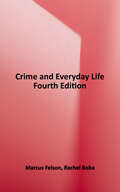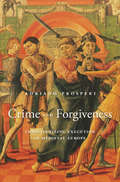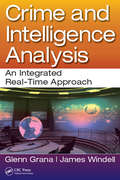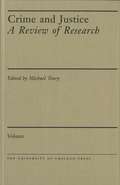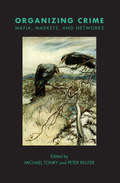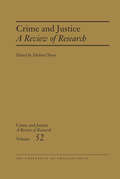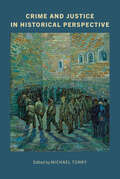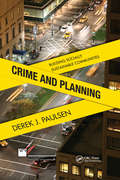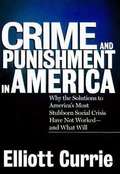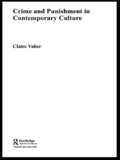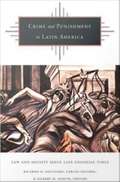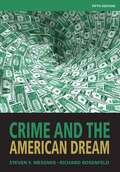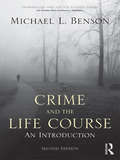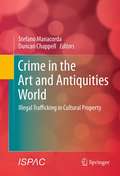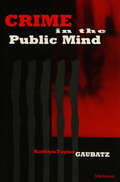- Table View
- List View
Crime and Everyday Life, Fourth Edition
by Marcus Felson Rachel BobaCrime and Everyday Life, Fourth Edition, provides an illuminating glimpse into the roots of criminal behavior, explaining how crime can touch us all in both small and large ways. This innovative text shows how opportunity is a necessary condition for crime to occur, while exploring realistic ways to reduce or eliminate crime and criminal behavior by removing the opportunity to complete the act. Encouraging students to take a closer look at the true nature of crime and its effects on their lives, author Marcus Felson and new co-author Rachel L. Boba (an expert on crime prevention, crime analysis and mapping, and school safety) maintain the book’s engaging, readable, and informative style, while incorporating the most current research on criminal behavior and routine activity theory. The authors emphasize that routine daily activities set the stage for illegal acts, thus challenging conventional wisdom and offering students a fresh perspective, novel solutions for reducing crime . . . and renewed hope. New and Proven Features - Includes new coverage of gangs, bar problems, and barhopping; new discussion of the dynamic crime triangle; and expanded coverage of technology, Internet fraud, identity theft, and other Internet pitfalls - The now-famous “fallacies about crime” are reduced to nine and are organized and explained even more clearly than in past editions - Offers updated research on crime as well as new examples of practical application of theory, with the most current crime and victimization statistics throughout - Features POP (Problem-Oriented Policing) Center guidelines and citations, including Closing Streets and Alleys to Reduce Crime, Speeding in Residential Areas, Robbery of Convenience Stores, and use of the Situational Crime Prevention Evaluation Database - Updated “Projects and Challenges” at the end of each chapter
Crime and Forgiveness: Christianizing Execution in Medieval Europe
by Adriano ProsperiA provocative analysis of how Christianity helped legitimize the death penalty in early modern Europe, then throughout the Christian world, by turning execution into a great cathartic public ritual and the condemned into a Christ-like figure who accepts death to save humanity. The public execution of criminals has been a common practice ever since ancient times. In this wide-ranging investigation of the death penalty in Europe from the fourteenth to the eighteenth century, noted Italian historian Adriano Prosperi identifies a crucial period when legal concepts of vengeance and justice merged with Christian beliefs in repentance and forgiveness. Crime and Forgiveness begins with late antiquity but comes into sharp focus in fourteenth-century Italy, with the work of the Confraternities of Mercy, which offered Christian comfort to the condemned and were for centuries responsible for burying the dead. Under the brotherhoods’ influence, the ritual of public execution became Christianized, and the doomed person became a symbol of the fallen human condition. Because the time of death was known, this “ideal” sinner could be comforted and prepared for the next life through confession and repentance. In return, the community bearing witness to the execution offered forgiveness and a Christian burial. No longer facing eternal condemnation, the criminal in turn publicly forgave the executioner, and the death provided a moral lesson to the community. Over time, as the practice of Christian comfort spread across Europe, it offered political authorities an opportunity to legitimize the death penalty and encode into law the right to kill and exact vengeance. But the contradictions created by Christianity’s central role in executions did not dissipate, and squaring the emotions and values surrounding state-sanctioned executions was not simple, then or now.
Crime and Intelligence Analysis: An Integrated Real-Time Approach
by James Windell Glenn GranaCrime and Intelligence Analysis: An Integrated Real-Time Approach covers everything crime analysts and tactical analysts need to know to be successful. Providing an overview of the criminal justice system as well as the more fundamental areas of crime analysis, the book will enable students and law enforcement personnel to better understand criminal behavior, learn the basics of conducting temporal analysis of crime patterns, use spatial analysis to better understand crime, apply research methods to crime analysis, and more successfully evaluate data and information to help predict criminal offending and solve criminal cases. Criminal justice and police academy students will learn how to be skilled and credible crime analysts who play a critical role in the daily operations of law enforcement.
Crime and Justice, Volume 41: Prosecutors and Politics: A Comparative Perspective (Crime and Justice: A Review of Research #41)
by The University of Chicago PressProsecutors are powerful figures in any criminal justice system. They decide what crimes to prosecute, whom to pursue, what charges to file, whether to plea bargain, how aggressively to seek a conviction, and what sentence to demand. In the United States, citizens can challenge decisions by police, judges, and corrections officials, but courts keep their hands off the prosecutor. Curiously, in the United States and elsewhere, very little research is available that examines this powerful public role. And there is almost no work that critically compares how prosecutors function in different legal systems, from state to state or across countries. Prosecutors and Politics begins to fill that void. Police, courts, and prisons are much the same in all developed countries, but prosecutors differ radically. The consequences of these differences are enormous: the United States suffers from low levels of public confidence in the criminal justice system and high levels of incarceration; in much of Western Europe, people report high confidence and support moderate crime control policies; in much of Eastern Europe, people’s perceptions of the law are marked by cynicism and despair. Prosecutors and Politics unpacks these national differences and provides insight into this key area of social control. Since 1979 the Crime and Justice series has presented a review of the latest international research, providing expertise to enhance the work of sociologists, psychologists, criminal lawyers, justice scholars, and political scientists. The series explores a full range of issues concerning crime, its causes, and its cure.
Crime and Justice, Volume 42
by Michael TonryFor the American criminal justice system, 1975 was a watershed year. Offender rehabilitation and individualized sentencing fell from favor. The partisan politics of "law and order" took over. Among the results four decades later are the world's harshest punishments and highest imprisonment rate. Policymakers' interest in what science could tell them plummeted just when scientific work on crime, recidivism, and the justice system began to blossom. Some policy areas--sentencing, gun violence, drugs, youth violence--became evidence-free zones. In others--developmental crime prevention, policing, recidivism studies, evidence mattered. Crime and Justice in America: 1975-2025 tells how policy and knowledge did and did not interact over time and charts prospects for the future. What accounts for the timing of particular issues and research advances? What did science learn or reveal about crime and justice, and how did that knowledge influence policy? Where are we now, and, perhaps even more important, where are we going? The contributors to this volume, the leading scholars in their fields, bring unsurpassed breadth and depth of knowledge to bear in answering these questions. They include Philip J. Cook, Francis T. Cullen, Jeffrey Fagan, David Farrington, Daniel S. Nagin, Peter Reuter, Lawrence W. Sherman, and Franklin E. Zimring. For thirty-five years, the Crime and Justice series has provided a platform for the work of sociologists, psychologists, criminal lawyers, justice scholars, and political scientists as it explores the full range of issues concerning crime, its causes, and it remedies.
Crime and Justice, Volume 42: Crime and Justice in America: 1975-2025 (Crime and Justice: A Review of Research #42)
by The University of Chicago PressFor thirty-five years, the Crime and Justice series has provided a platform for the work of sociologists, psychologists, criminal lawyers, justice scholars, and political scientists as it explores the full range of issues concerning crime, its causes, and it remedies. For the American criminal justice system, 1975 was a watershed year. Offender rehabilitation and individualized sentencing fell from favor and the partisan politics of “law and order” took over. Policymakers’ interest in science declined just as scientific work on crime, recidivism, and the justice system began to blossom. Some policy areas—in particular, sentencing, gun violence, drugs, and youth violence—became evidence-free zones. Crime and Justice in America: 1975-2025 tells the complicated relationship between policy and knowledge during this crucial time and charts prospects for the future. The contributors to this volume, the leading scholars in their fields, bring unsurpassed breadth and depth of knowledge to bear in answering these questions. They include Philip J. Cook, Francis T. Cullen, Jeffrey Fagan, David Farrington, Daniel S. Nagin, Peter Reuter, Lawrence W. Sherman, and Franklin E. Zimring.
Crime and Justice, Volume 45: Sentencing Policies and Practices in Western Countries: Comparative and Cross-National Perspectives (Crime and Justice: A Review of Research #45)
by The University of Chicago PressSentencing Policies and Practices in Western Countries: Comparative and Cross-national Perspectives is the forty-fifth addition to the Crime and Justice series. Contributors include Thomas Weigend on criminal sentencing in Germany since 2000; Julian V. Roberts and Andrew Ashworth on the evolution of sentencing policy and practice in England and Wales from 2003 to 2015; Jacqueline Hodgson and Laurène Soubise on understanding the sentencing process in France; Anthony N. Doob and Cheryl Marie Webster on Canadian sentencing policy in the twenty-first century; Arie Freiberg on Australian sentencing policies and practices; Krzysztof Krajewski on sentencing in Poland; Alessandro Corda on Italian policies; Michael Tonry on American sentencing; and Tapio Lappi-Seppälä on penal policy and sentencing in the Nordic countries.
Crime and Justice, Volume 46: Reinventing American Criminal Justice (Crime and Justice: A Review of Research #46)
by The University of Chicago PressJustice Futures: Reinventing American Criminal Justice is the forty-sixth volume in the Crime and Justice series. Contributors include Francis Cullen and Daniel Mears on community corrections; Peter Reuter and Jonathan Caulkins on drug abuse policy; Harold Pollack on drug treatment; David Hemenway on guns and violence; Edward Mulvey on mental health and crime; Edward Rhine, Joan Petersilia, and Kevin Reitz on parole policies; Daniel Nagin and Cynthia Lum on policing; Craig Haney on prisons and incarceration; Ronald Wright on prosecution; and Michael Tonry on sentencing policies.
Crime and Justice, Volume 47: A Review of Research (Crime and Justice: A Review of Research #47)
by The University of Chicago PressSince 1979, the Crime and Justice series has presented a review of the latest international research, providing expertise to enhance the work of sociologists, psychologists, criminal lawyers, justice scholars, and political scientists. The series explores a full range of issues concerning crime, its causes, and its cures. In both the review and the thematic volumes, Crime and Justice offers an interdisciplinary approach to address core issues in criminology. Volume 47 will be a review volume featuring, among other selections, a top-of-class impact ranking.
Crime and Justice, Volume 48: American Sentencing (Crime and Justice: A Review of Research #48)
by The University of Chicago PressAmerican Sentencing provides an up-to-date and comprehensive overview of efforts in the state and the federal systems to make sentencing fairer, reduce overuse of imprisonment, and help offenders live law-abiding lives. It addresses a variety of topics and themes related to sentencing and reform, including racial disparities, violence prediction, plea negotiation, case processing, federal and state guidelines, California’s historic “realignment,” and more. This volume covers what students, scholars, practitioners, and policy makers need to know about how sentencing really works, what a half century’s “reforms” have and have not accomplished, how sentencing processes can be made fairer, and how sentencing outcomes can be made more just. Its writers are among America’s leading scholarly specialists—often the leading specialist—in their fields. Clearly and accessibly written, American Sentencing is ideal for teaching use in seminars and courses on sentencing, courts, and criminal justice. Its authors’ diverse perspectives shed light on these issues, making it likely the single, most authoritative source of information on the state of sentencing in America today.
Crime and Justice, Volume 49: Organizing Crime: Mafias, Markets, and Networks (Crime and Justice: A Review of Research)
by The University of Chicago PressFor most Americans, The Godfather, The Sopranos, and the Cosa Nostra exemplify organized crime. In Asia the term conjures up images of Japanese yakuza and Chinese triads, in Italy the Cosa Nostra and ‘Ndrangheta, in Latin America Mexican narco-gangs and Colombian drug cartels, in the Netherlands transnational drug and human trafficking, and in Scandinavia outlaw motorcycle gangs. Some but not all those organizations are “mafias” with centuries-long histories, distinctive cultures, and complicated relationships with local communities and governments. Others are new, large but transitory and with no purpose other than maximizing profits from illegal markets. Organized crime organizations have existed for centuries. Serious scholarly, as opposed to journalistic or law enforcement, efforts to understand them, however, date back only a few decades. Authoritative overviews were, until very recently, impossible. Rigorous, analytically acute, and methodologically sophisticated literatures did not exist. They have begun to emerge. They have developed in many countries, involve work in different languages and disciplines, and deploy a wide range of methods. Organizing Crime: Mafias, Markets, and Networks provides the most exhaustive overview ever published of knowledge about organized crime. It provides intensive accounts of American, Italian, and Dutch developments, covers both national mafias and transnational criminality, and delves in depth into gender, human capital, and money laundering issues. The writers are based in seven countries. To a person they are, or are among, the world’s most distinguished specialists in their subjects. At last, credible explanations and testable hypotheses are available concerning when, why, and under what circumstances mafias and other organized crime organizations come into being, what makes them distinctive, what they do and with what effects, and how to contain them.
Crime and Justice, Volume 52: A Review of Research (Crime and Justice: A Review of Research #52)
by The University of Chicago PressVolume 52 is an annual survey of cutting-edge issues by preeminent criminology scholars. Since 1979, Crime and Justice has presented a review of the latest international research, providing expertise to enhance the work of sociologists, psychologists, criminal lawyers, justice scholars, and political scientists. The series explores a full range of issues concerning crime, its causes, and its cures. In both the review and the thematic volumes, Crime and Justice offers an interdisciplinary approach to address core issues in criminology.
Crime and Justice, Volume 53: Crime and Justice in Historical Perspective (Crime and Justice: A Review of Research #53)
by The University of Chicago PressPresents cutting-edge scholarship by preeminent criminology scholars. Since 1979, Crime and Justice has presented a review of the latest international research, providing expertise to enhance the work of sociologists, psychologists, criminal lawyers, justice scholars, and political scientists. The series explores a full range of issues concerning crime, its causes, and its cures. In both the review and the thematic volumes, Crime and Justice offers an interdisciplinary approach to address core issues in criminology.
Crime and Planning: Building Socially Sustainable Communities
by Ph.D., Derek PaulsenThe form and layout of a built environment has a significant influence on crime by creating opportunities for it and, in turn, shaping community crime patterns. Effective urban planners and designers will consider crime when making planning and design decisions. A co-publication with the American Planning Association, Crime and Planning:
Crime and Punishment in America
by Elliott CurrieThere are five times as many Americans behind bars today as in 1970. The national incarceration rate in 1997 was twice that in 1985. California's prison system has become the third largest in the world.
Crime and Punishment in Contemporary Culture (International Library of Sociology)
by Claire ValierToday, questions about how and why societies punish are deeply emotive and hotly contested. In Crime and Punishment in Contemporary Culture, Claire Valier argues that criminal justice is a key site for the negotiation of new collective identities and modes of belonging. Exploring both popular cultural forms and changes in crime policies and criminal law, Valier elaborates new forms of critical engagement with the politics of crime and punishment. In doing so, the book discusses:· Teletechnologies, punishment and new collectivities· The cultural politics of victims rights· Discourses on foreigners, crime and diaspora· Terror, the death penalty and the spectacle of violence.Crime and Punishment in Contemporary Culture makes a timely and important contribution to debate on the possibilities of justice in the media age.
Crime and Punishment in Latin America: Law and Society since Late Colonial Times
by Gilbert M. Joseph Ricardo D. Salvatore Carlos AguirreCrowning a decade of innovative efforts in the historical study of law and legal phenomena in the region, Crime and Punishment in Latin America offers a collection of essays that deal with the multiple aspects of the relationship between ordinary people and the law. Building on a variety of methodological and theoretical trends--cultural history, subaltern studies, new political history, and others--the contributors share the conviction that law and legal phenomena are crucial elements in the formation and functioning of modern Latin American societies and, as such, need to be brought to the forefront of scholarly debates about the region's past and present. While disassociating law from a strictly legalist approach, the volume showcases a number of highly original studies on topics such as the role of law in processes of state formation and social and political conflict, the resonance between legal and cultural phenomena, and the contested nature of law-enforcing discourses and practices. Treating law as an ambiguous and malleable arena of struggle, the contributors to this volume--scholars from North and Latin America who represent the new wave in legal history that has emerged in recent years-- demonstrate that law not only produces and reformulates culture, but also shapes and is shaped by larger processes of political, social, economic, and cultural change. In addition, they offer valuable insights about the ways in which legal systems and cultures in Latin America compare to those in England, Western Europe, and the United States. This volume will appeal to scholars in Latin American studies and to those interested in the social, cultural, and comparative history of law and legal phenomena. Contributors. Carlos Aguirre, Dain Borges, Lila Caimari, Arlene J. Daz, Luis A. Gonzalez, Donna J. Guy, Douglas Hay, Gilbert M. Joseph, Juan Manuel Palacio, Diana Paton, Pablo Piccato, Cristina Rivera Garza, Kristin Ruggiero, Ricardo D. Salvatore, Charles F. Walker
Crime and Security (International Library Of Criminology, Criminal Justice And Penology - Second Ser.)
by Lucia Zedner Benjamin GooldThe pursuit of security is now central to the development of public policy and a driving force behind the spread of private policing. Just as new theoretical frameworks are needed to deal with the increasing tendency of crime control policies to focus on risk reduction, new forms of governance are also required to deal with the rapid growth of the private security industry. This volume brings together a wide range of contributions from leading scholars in the field and includes international and comparative perspectives on the challenges posed by the rise of the 'security society'.
Crime and the American Dream
by Richard Rosenfeld Steven F. MessnerHow has America's over-emphasis on the pursuit of materialistic gain contributed to the it's high rate of violent crime? CRIME AND THE AMERICAN DREAM, 5th Edition is an easy-to-understand book that attempts to answer that question using seminal criminological theory.
Crime and the Construction of Forensic Objectivity from 1850: Space, Media, Experts And Ethics (Palgrave Histories of Policing, Punishment and Justice)
by Alison AdamThis book charts the historical development of 'forensic objectivity' through an analysis of the ways in which objective knowledge of crimes, crime scenes, crime materials and criminals is achieved. Taking an interdisciplinary approach, with authors drawn from law, history, sociology and science and technology studies, this work shows how forensic objectivity is constructed through detailed crime history case studies, mainly in relation to murder, set in Scotland, England, Germany, Sweden, USA and Ireland. Starting from the mid-nineteenth century and continuing to the present day, the book argues that a number of developments were crucial. These include: the beginning of crime photography, the use of diagrams and models specially constructed for the courtroom so jurors could be ‘virtual witnesses’, probabilistic models of certainty, the professionalization of medical and scientific expert witnesses and their networks, ways of measuring, recording and developing criminal records and the role of the media, particularly newspapers in reporting on crime, criminals and legal proceedings and their part in the shaping of public opinion on crime. This essential title demonstrates the ways in which forensic objectivity has become a central concept in relation to criminal justice over a period spanning 170 years.
Crime and the Life Course
by Michael BensonIn recent years, the lifecourse perspective has become a popular theoretical orientation toward crime. Yet despite its growing importance in the field of criminology, most textbooks give it only cursory treatment. Crime and the Lifecourse: An Introduction by Michael L. Benson provides a comprehensive overview of contemporary research and theory on the life-course approach to crime. The book emphasizes a conceptual understanding of this approach. A special feature is the integration of qualitative and quantitative research on criminal life histories. This book: provides an overview of the life course approach and describes the major concepts and issues in lifecourse theory as it applies to criminology reviews evidence on biological and genetic influences on crime reviews research on the role of the family in crime and juvenile delinquency provides a detailed discussion of the criminological lifecourse theories of Moffitt, Hagan, Sampson and Laub, and others discusses the connections between youthful crime and adult outcomes in education, occupation, and marriage presents an application of the lifecourse approach to white-collar crime discusses how macro sociological and historical developments have influenced the shape of the lifecourse in American society as it relates to patterns in crime.
Crime in the Art and Antiquities World: Illegal Trafficking in Cultural Property
by Stefano Manacorda Duncan ChappellThe theft, trafficking, and falsification of cultural property and cultural heritage objects are crimes of a particularly complex nature, which often have international ramifications and significant economic consequences. Organized criminal groups of various types and origins are involved in these illegal acts. The book Crime in the Art and Antiquities World has contributions both from researchers specializing in the illegal trafficking of art, and representatives of international institutions involved with prevention and detection of cultural property-related crimes, such as Interpol and UNESCO. This work is a unique and useful reference for scholars and private and public bodies alike. This innovative volume also includes an Appendix of the existing legal texts, i.e. international treaties, conventions, and resolutions, which have not previously been available in a single volume. As anyone who has undertaken research or study relating to the protection of cultural heritage discovers one of the frustrations encountered is the absence of ready access to the multi- various international instruments which exist in the field. Since the end of the Second World War these instruments have proliferated, first in response to increasing recognition of the need for concerted multinational action to give better protection to cultural property during armed conflict as well as ensuring the repatriation of cultural property looted during such conflict. Thus the international community agreed in 1954 upon a Convention for the Protection of Cultural Property in the Event of Armed Conflict. That Convention, typically referred to as the Hague Convention of 1954, is now to be found reproduced in the Appendix to this book (Appendix I) together with 25 other important and diverse documents that we believe represent a core of the essential international sources of reference in this subject area. In presenting these documents in one place we hope that readers will now experience less frustration while having the benefit of supplementing their understanding and interpretation of the various instruments by referring to individual chapters in the book dealing with a particular issue or topic. For example, Chapter 9 by Mathew Bogdanos provides some specific and at times rather depressing descriptions of the application in the field of the Hague Convention 1954, and its Protocols (Appendices II and III), to the armed conflict in Iraq. Reference may also be had to the resolution of the UN Security Council in May 2003 (Appendix VI) urging Member States to take appropriate steps to facilitate the safe return of looted Iraqi cultural property taken from the Iraq National Museum, the National Library and other locations in Iraq. Despite such pleas the international antiquities market seems to have continued to trade such looted property in a largely unfettered manner, as demonstrated by Neil Brodie in Chapter 7. Fittingly, as referred to in the Preface to this book, the last document contained in the Appendix (Appendix 26) is the "Charter of Courmayeur", formulated at a ground breaking international workshop on the protection of cultural property conducted by the International Scientific and Professional Advisory Council (ISPAC) to the United Nations Crime Prevention and Criminal Justice Program in Courmayeur, Italy, in June 1992. The Charter makes mention of many of the instruments contained in the Appendix while also foreshadowing many of the developments which have taken place in the ensuing two decades designed to combat illicit trafficking in cultural property through international collaboration and action in the arena of crime prevention and criminal justice.
Crime in the Public Mind
by Kathlyn Taylor GaubatzCrime in the Public Mind explores the politics of crime and criminal justice, examining in depth what Americans think about penalties for criminal offenders. While some are resigned, others are desperate; a few are hopeful and forgiving, but most are frustrated and angry. In fact, fully eighty percent of the population believes that the court system should deal more harshly with criminal offenders. In this readable account, Kathlyn Taylor Gaubatz makes use of intensive interviews with Americans from varied walks of life in order to reveal the fascinating nuances in the public's views on criminal justice, and in their motivations for holding these views. She questions our easy acceptance of the very existence of a public consensus around such a complex, intractable issue as crime. Why do Americans support harsh penal policies when crime rates are actually falling? How does this attitude square with our increasingly liberal social ideas? What logic is there to support stiff sentencing when the vast majority of the public acknowledges that prisons have been powerless to reduce crime in our nation to an acceptable level? The author powerfully weaves narratives from those she interviewed to construct an in-depth theory about who joins and who spurns the consensus on criminal justice. She explores the complex relationship between our political beliefs and our attitudes toward crime, revealing in some cases a telling dissonance. Through careful argumentation and demonstration, Crime in the Public Mind concludes that Americans have become harsher on crime not in spite of becoming more liberal on a variety of other social issues, but at least in part because we have done so. At a time when crime has been called the political issue of the decade, Crime in the Public Mind forces us to confront our assumptions, to sort through our fear. It gives us an opportunity to balance our desire for safety and our desire to see justice done with our innate compassion and understanding. By exposing the paradoxes of our beliefs, the author pushes us to reconsider whether incarceration really is the answer to every criminal offense and invites us to contemplate saner and perhaps more effective approaches to criminal justice. "In the great tradition of Robert Lane's Political Ideology, Gaubatz has discovered that what the 'common man' (and woman) believes about crime and punishment is more complicated than the polling numbers would allow. While clearly in sympathy with those who dissent from get-tough approaches, she offers a balanced, insightful, and timely understanding of public attitudes about criminal justice. Experts, policymakers, students, and concerned citizens should read this fine book."- John J. DiIulio, Jr., Princeton University and Director, Brookings Institution Center for Public Management Kathlyn Taylor Gaubatz holds a Ph.D. in politics from Princeton University and is Executive Director of a non profit agency that provides housing, counseling, child-care, and other services to homeless families and individuals in San Franciso.
Crime of Aggression Library: A Commentary
by Stefan Barriga Claus KreßThe 2010 Kampala Amendments to the Rome Statute empowered the International Criminal Court to prosecute the 'supreme crime' under international law: the crime of aggression. This landmark commentary provides the first analysis of the history, theory, legal interpretation and future of the crime of aggression. As well as explaining the positions of the main actors in the negotiations, the authoritative team of leading scholars and practitioners set out exactly how countries have themselves criminalized illegal war-making in domestic law and practice. In light of the anticipated activation of the Court's jurisdiction over this crime in 2017, this work offers, over two volumes, a comprehensive legal analysis of how to understand the material and mental elements of the crime of aggression as defined at Kampala. Alongside The Travaux Préparatoires of the Crime of Aggression (Cambridge, 2011), this commentary provides the definitive resource for anyone concerned with the illegal use of force. The world's leading experts - from both the academy and the Kampala Conference negotiations - come together in these volumes to provide the definitive commentary on the international crime of aggression Situates the crime of aggression amendments to the Rome Statute within a wider historical, theoretical and political context Offers a wide-reaching analysis of legislation spanning several national jurisdictions, provides insightful policy assessments by representatives of key State actors, and comprehensively sets out the position of the crime under international law Comprehensively examines the elements of the crime, to assist practitioners and scholars in its interpretation
Crime of Privilege
by Walter WalkerIn the tradition of Scott Turow, William Landay, and Nelson DeMille, Crime of Privilege is a stunning thriller about power, corruption, and the law in America--and the dangerous ways they come together. A murder on Cape Cod. A rape in Palm Beach. All they have in common is the presence of one of America's most beloved and influential families. But nobody is asking questions. Not the police. Not the prosecutors. And certainly not George Becket, a young lawyer toiling away in the basement of the Cape & Islands district attorney's office. George has always lived at the edge of power. He wasn't born to privilege, but he understands how it works and has benefitted from it in ways he doesn't like to admit. Now, an investigation brings him deep inside the world of the truly wealthy--and shows him what a perilous place it is. Years have passed since a young woman was found brutally slain at an exclusive Cape Cod golf club, and no one has ever been charged. Cornered by the victim's father, George can't explain why certain leads were never explored--leads that point in the direction of a single family--and he agrees to look into it. What begins as a search through the highly stratified layers of Cape Cod society, soon has George racing from Idaho to Hawaii, Costa Rica to France to New York City. But everywhere he goes he discovers people like himself: people with more secrets than answers, people haunted by a decision years past to trade silence for protection from life's sharp edges. George finds his friends are not necessarily still friends and a spouse can be unfaithful in more ways than one. And despite threats at every turn, he is driven to reconstruct the victim's last hours while searching not only for a killer but for his own redemption.Advance praise for Crime of Privilege "Walter Walker's Crime of Privilege is a terrifically entertaining race of a read that also effortlessly manages to be jam-packed with intelligence, insight, morality, and heart. Top-notch and highly recommended!"--New York Times bestselling author John Lescroart "A stunning first legal thriller that is sure to get as much attention as John Grisham's The Firm and Scott Turow's Presumed Innocent . . . An outstanding crime story with spot-on characterization, a protagonist whose humiliating past compels sympathy, and a host of unexpected suspects. The novel's moral complexity will appeal to readers who enjoyed works as diverse as Tom Wolfe's Bonfire of the Vanities, Nelson DeMille's The Gold Coast, and any number of contemporary thrillers."--Library Journal (starred review) "A sheer pleasure to read . . . George must find his own moral compass, in a summer read notable for credible characters and unpredictable twists."--Publishers Weekly (starred review) "A page-turning, puzzle-solving adventure."--Booklist "Walker maintains his dry, sometimes biting humor and moral edge. . . . A convincing portrait of misbehavior among the rich and powerful."--Kirkus Reviews"Walter Walker combines an experienced attorney's sense of our flawed criminal justice system with a natural storyteller's gift. Crime of Privilege is a twisting, engrossing, irresistible detective story."--William Landay, author of Defending JacobFrom the Hardcover edition.
